Apatosaurus has come a long way over the years. What was once a sluggish swamp-dwelling behemoth is now more tightly built, with muscular columns of legs supporting a powerful body, graceful neck, and elegant whip-like tail. As the rest of the world struggles to keep pace with the latest paleontological research, David Krentz is always perched on the cutting edge. With his own line of Antediluvian resin models, he doesn’t have to worry about cigar-chomping studio executives or the child-safety features. He is free to sculpt dinosaurs as he sees fit, and the result for our dear old diplodocoid is nothing less than astounding.
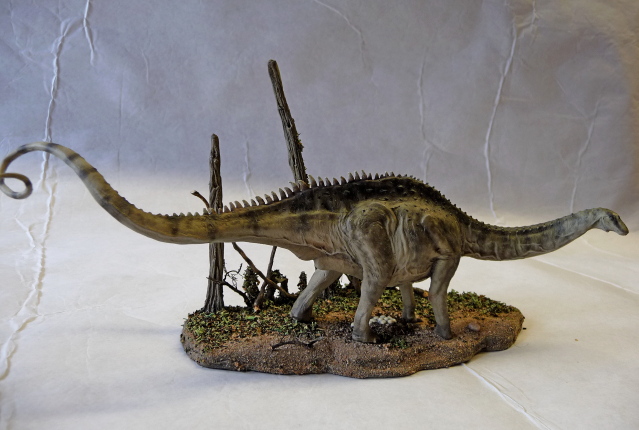
As we all know, resin models can do a lot of things mass-produced figures cannot. It’s true that fine detailing is becoming more common in figures nowadays, but slender and sharp extremities are particularly rare; certainly the aforementioned child safety concerns are a factor. From this standpoint, poor Apatosaurus can be a logistical nightmare. His whip-tail is long and tapers to a miniscule thickness, and the overall body length provides additional complications when he’s being reconstructed at a larger scale. Fortunately, our 1:72 scale hero is a mere 10 inches long – bigger than any other Antediluvian, but plenty of room to show off the artist’s attention to detail.
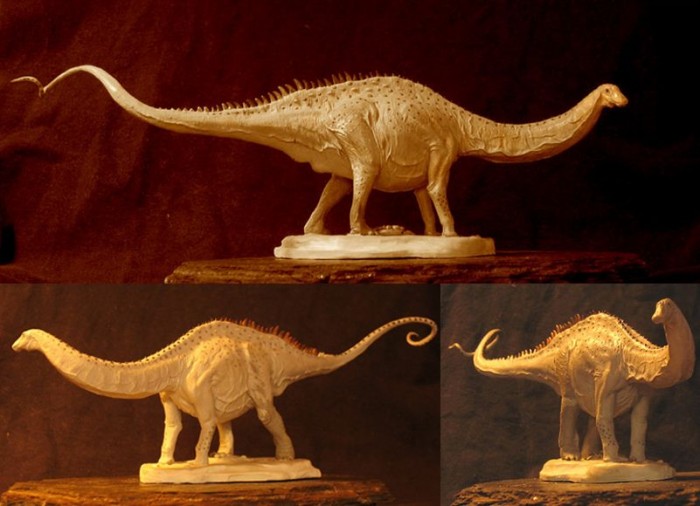
It should be noted that David has elected to reconstruct the species type A. louisae for this figure. This species was named after Andrew Carnegie’s wife, and any visitor to the Carnegie Museum can find an impressive skeletal reconstruction of this species on display. Not unlike the exhibit, this model has its neck craned to the right, possibly a subtle nod to the current exhibit.
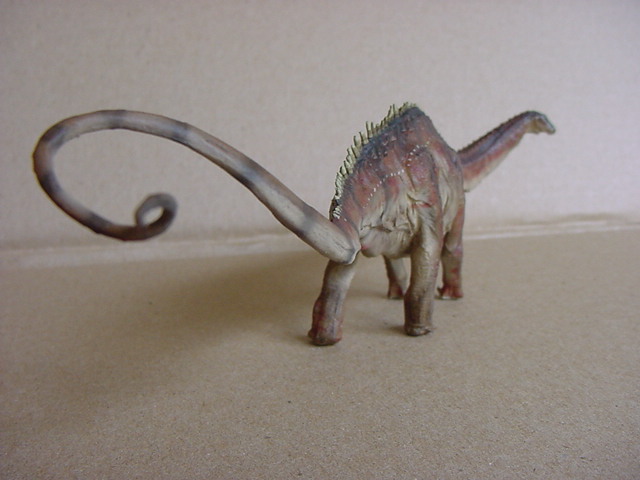
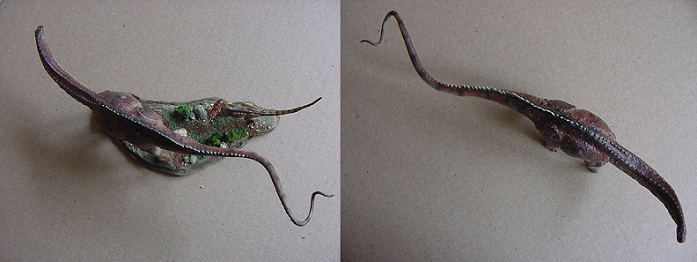
One common error in sauropod reconstruction relates to the feet. Trackway evidence shows that the front feet left a somewhat horseshoe-like print, so the animal was at least partially digitigrade. As such, David has the correctly formed feet here in all their glory. Sauropod foot fetishists, rejoice. Some diplodocoids have been found with dermal spines, so David has implemented them here as well. This is actually a feature that David adds to many of his reconstructions, as fans of his work will no doubt notice. The rows of tiny, sharp little projections are nowhere to be found in mass-produced replicas, so it’s nice to see he’s taken full advantage of the resin medium. In fact, the only real cleanup work required here would involve cutting out the tiny twigs of resin between the spikes. They are reduced to small knobs at either extreme of the animal’s body, and the high ridge along the back is properly bifurcated at the neck. This leaves a nice little channel that Fred Flintstone would presumably slide down at the conclusion of his work day; sliding down the other direction with the spines would cause quite a mess, certainly impairing his ability to further perpetuate his genes.
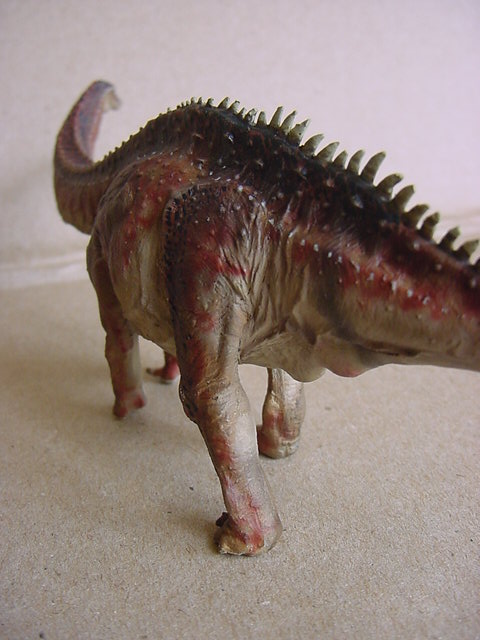
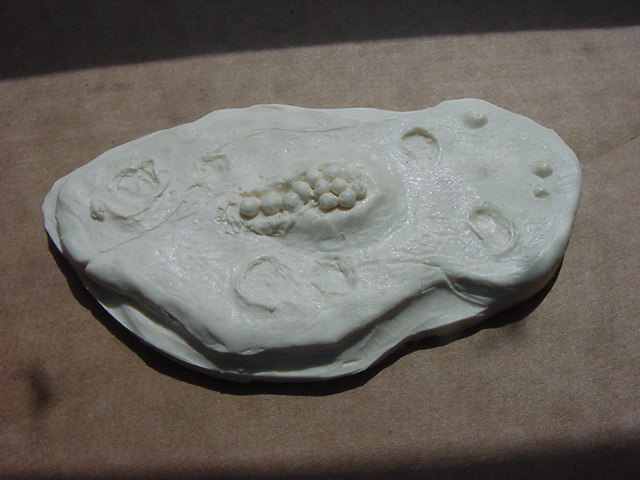
The Antediluvian Apatosaurus comes in a two piece kit, just the animal and the base. Since it stands comfortably with or without the base, no complicated assembly or glue is required. Many people – myself included – actually like this simple “marble statue” quality for the unpainted model. However, it should be noted that resin will yellow with age, so a simple coat of white paint might be a good idea. It seems mid-range tones are actually ideal for showing off the surface texture, but you can play with the lighting until you achieve the desired effect. The base is unique in that it contains a nest full of eggs sculpted right into it. For the buildups in these photos, the base was heavily embellished by Martin Garratt, who is known to customize in wondrous ways with realistic soil, bits of wood, shrubbery, and more. The first buildup shown in this review is a charcoal coloration in an arboreal setting; the other photos show my own piece, which is in a burnt sienna with some flashy eyespots. The enlarged “combo” base is also a customized feature that Martin offers, and for this particular buildup, I requested to have the Antediluvian Allosaurus attached (normally he’s sold separately, but my sophisticated intellectual side said, “Why the heck not?”)
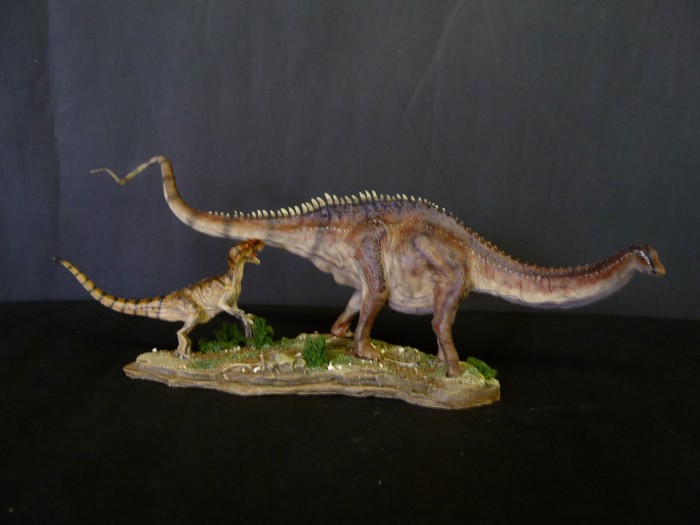
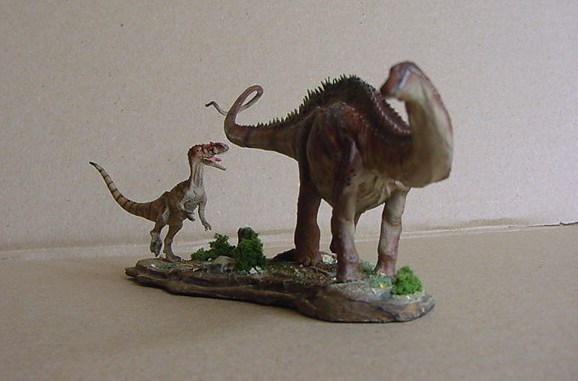
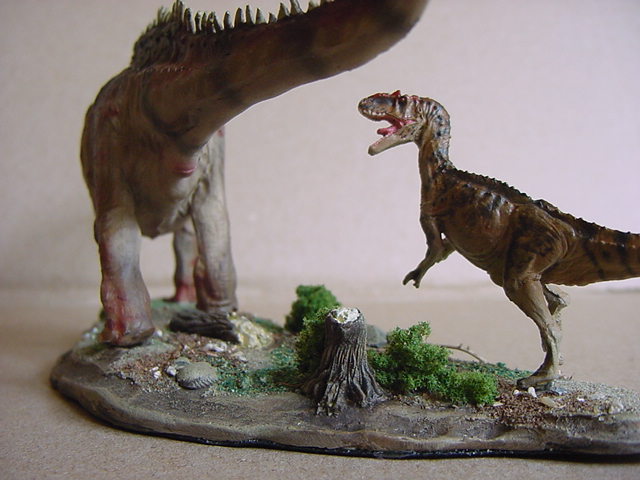
Granted, this was probably not a common sight in the late Jurassic, as Allosaurus would at least need to band together with some buddies to take down such an enormous prey item. Perhaps this is a brazen, bored subadult Allosaurus just pestering the sauropod for fun. Maybe it’s an agitated mother, trying to shepherd the giant away from her nesting grounds. Either way, it looks amazing.
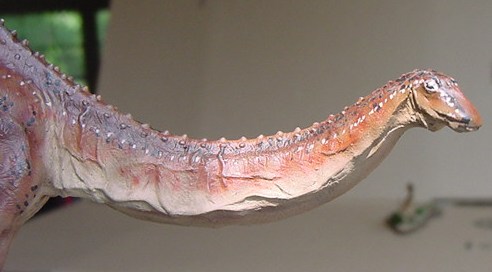
Despite the popularity of Apatosaurus, it seems oddly difficult to find diplodocoid figures that are both beautiful and accurate. Fortunately, the Antediluvian reconstruction has both in spades, and won’t break the bank quite like a larger resin piece. It seems pretentious to try and quantify such a piece as “five star quality,” so I am content to call it a work of art. Let’s be honest. Most of you are not even reading this text right now. You’re probably staring at the photos while long strands of saliva fall from your mouth to your keyboard. Don’t worry, I’m not going to take it personally – this is an amazing Apatosaurus, and well worth drooling over, despite the questionable quality of my camera. If you’ve yet to make the leap to resin models, this piece will make the conversion easy and painless. My highest recommendation.
Disclaimer: links to Ebay and Amazon on the DinoToyBlog are affiliate links, so we make a small commission if you use them. Thanks for supporting us!



There you go, sculptors – Mike Taylor has spoken!
Yes, this is truly an outstanding sauropod model — the best I have yet seen in production (though there is one in prep that may be better still … teaser!)
My only quibble with David’s anatomy is the concavity running along the top of the neck between the metapophyses of the bifid cervical neural spines. I doubt this profile of the bones was reflected in life; instead, air-sacs would have filled the trough.
An absolute winner in every way.
“Fred Flintstone?”
Yabba Dabba YES!!!
Fred Flintstone?
Wow. Okay, I think I got it right this time. That’s what I get for trying to crank out two reviews in one day. Thanks guys.
Oh dear oh dear. Dan corrected his typo with another typo. He will truly never live down this shame.
(I’m kidding. But on the other hand, I’m glad to see so many fellow anal typo-correctors.)
Guys, I hate to quibble in the shadow of such an amazing piece…but it’s actually “behemoth.”
Count me among the obnoxious few that have decided against riding the facebook wave. I just avoid everything to do with the thing. Kind of curmudgeony, eh? So pleased to hear you will be stocking them again, as I somehow missed them the first go-round. Thanks Dan, for the review (your build-ups are gorgeous!) and helping all of us add these to our collections.
Yep, the Krentz models are coming back, I’m just waiting on the caster. I think I mentioned this on the Facebook page as well.
Nice review Dan (ahem…behemoth)! However, need I point out the frustrating irony of such a review encouraging drooling folks to add this to their collection while is stands as “out of stock” on your website!? Will this lovely piece become available again sometime in the near future, or will we all just drown in drool (Eewww)?!
Fixed, thanks. That’s what I suspected, since “at least partially” doesn’t rule out “entirely”, does it?
Oh yeah, wouldn’t be living up to my reputation if I didn’t mention the typo in the second sentence (“behometh”)
The animal wasn’t ‘partially digitigrade’, it was entirely digitigrade – that is, it walked on its fingers and toes. Otherwise, nice review like 😉